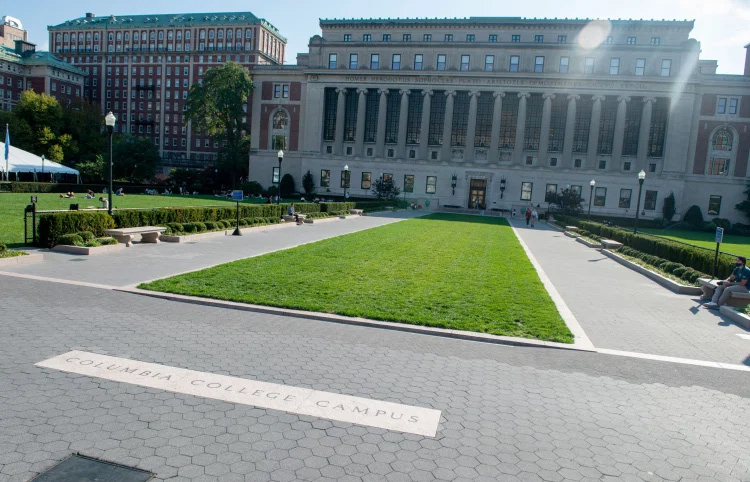哥伦比亚大学8成学生罢课,亲历者讲述原因

当前的大学生对他们所受教育的真正成本几乎一无所知。 1998年——在目前大多数本科生尚未出生之前,哥伦比亚大学(Columbia University)的学费为24,144美元,相当于今天的38,582美元。而现在,这笔费用已经激增至58,789美元,让哥伦比亚大学成为全美最昂贵的学校之一。同时,实际工资的增长已经趋于平缓。因此,在入学成本如此爆炸式般的增长下,学生成为了最大的受害人。目前,哥伦比亚大学的毕业生平均背负着21,979美元的债务。
哥伦比亚大学拥有110亿美元的捐赠基金,足以为学生提供他们负担得起的教育。没有人会觉得,入学成本加倍会使教育质量也翻一番。相反,哥伦比亚大学收取更多的费用,是为了支付其扩校所需的65亿美元——用来让近3.2万名西哈莱姆区的居民搬迁、给管理人员发放数百万美元的薪水和奢侈的津贴,以及打造一个过于豪华的公共安全部门。
美国高等教育的矛盾在哥伦比亚大学集中爆发。然而,在萧墙之内,哥伦比亚大学的学生正在反击。超过4,000名学生(占所有本科生和研究生人数的八分之一)已经联署支持美国历史上最大的学费罢课计划,目的是从根本上重新摆正大学的定位,提醒它们作为“大学”,应该将哪些事项放在首位,力求建立一个更加民主的机构。学生誓称将暂时不缴纳自己的学费,直到哥伦比亚大学将学费降低10%,经济援助提高10%,解决校园和西哈莱姆地区歧视黑人的种族主义问题,开始与研究生工会坦诚谈判,并向学生和社区提高投资决策的透明度,加大对资金的管控力度。
而重整大学与学生之间关系的愿景远远超出了哥伦比亚大学本身。哥伦比亚大学只是推动学费爆炸式上涨趋势的冰山一角,这种涨价的逻辑贯穿了整个高等教育界。当哥伦比亚大学提高学费时,其他大学也跟着做出同样的举动。当哥伦比亚大学将这些资金投资于奢侈的新发展和炫耀性地展示自己的财富、以吸引潜在的学生时,哥伦比亚大学的竞争对手也纷纷效仿。为了争夺最优秀、最聪明的美国青年,高校正在进行一场投建豪华设施的军备竞赛。然而,当高中生们被这些光鲜亮丽的事物诱惑后,进入大学的他们却发现,和沉重的债务相比,这些华而不实之物再无半点吸引力。
当前的新冠疫情让大学中核心的道德败坏问题得到了极大的缓解。回到潜藏着种种不稳定因素的家中,学生们常常坐在电脑前,上着通常缺乏足够经费的教授的网课。他们和他们的家人正在大萧条(Great Depression)以来最大的经济衰退中挣扎,前景一片惨淡——失业、数十万美元的学费债务、身兼数职以维持生计,以及对失去资助的持续焦虑。显然,一定有哪里出了什么问题。
事情也不是非要演变至此的。哥伦比亚大学的罢课学生的想法来自另外一所大学的愿景——该大学将学生、教职员工和周围社区的利益置于各类“世界高校排名”和塞满管理层的腰包之前。要求学生支付几乎与美国家庭收入中位数相当的学费是荒谬的,尤其是在世界上其他每个国家都能够以很小一部分的成本来提供相同质量的教育产品的情况下。(毕竟,哥伦比亚大学只是美国高等教育的痼疾中出现的最急性的症状之一,感染了美国所有的高等教育。)
哥伦比亚大学的管理层希望通过整个经济环境紧缩的逻辑来掩盖这种荒谬。他们坚称自己的手头也很紧张,因为大学的资金与捐赠基金的分配挂钩。他们“遗憾地告知”学生,即便他们可以满足学生的需求,但这也会以教师、学生和普通员工的利益为代价。
然而,这种逻辑根本不成立。哥伦比亚大学账面上有8.14亿美元,还有另外37亿美元专门用于支付“意外费用”,例如新冠疫情全球大流行造成的后果。普林斯顿大学、乔治城大学和威廉姆斯大学等同等机构已经在不牺牲教师、研究生或工人的情况下,出于疫情减免了学费。二十多年前的学生坐在同一张课桌前,接受同样的教诲,而要交的学费却只是今天的一小部分。
面对当前的危机,学生们识破了“经济紧缩”的谎言。1月22日,我们成千上万的学生表示将拒绝支付春季学期的学费,并继续保留这笔钱,直到满足我们的要求为止——我们已经赢得了校方许多有意义的让步——包括给一些学生提供紧急资助——但这远远不够。我们希望能够赢得更多。一所崭新的大学近在咫尺——现在,学生正在抓住这个机会。
汤森德•纳尔逊是哥伦比亚大学的高年级学生,也是学费罢课的组织者之一。(财富中文网)
编译:陈聪聪
当前的大学生对他们所受教育的真正成本几乎一无所知。 1998年——在目前大多数本科生尚未出生之前,哥伦比亚大学(Columbia University)的学费为24,144美元,相当于今天的38,582美元。而现在,这笔费用已经激增至58,789美元,让哥伦比亚大学成为全美最昂贵的学校之一。同时,实际工资的增长已经趋于平缓。因此,在入学成本如此爆炸式般的增长下,学生成为了最大的受害人。目前,哥伦比亚大学的毕业生平均背负着21,979美元的债务。
哥伦比亚大学拥有110亿美元的捐赠基金,足以为学生提供他们负担得起的教育。没有人会觉得,入学成本加倍会使教育质量也翻一番。相反,哥伦比亚大学收取更多的费用,是为了支付其扩校所需的65亿美元——用来让近3.2万名西哈莱姆区的居民搬迁、给管理人员发放数百万美元的薪水和奢侈的津贴,以及打造一个过于豪华的公共安全部门。
美国高等教育的矛盾在哥伦比亚大学集中爆发。然而,在萧墙之内,哥伦比亚大学的学生正在反击。超过4,000名学生(占所有本科生和研究生人数的八分之一)已经联署支持美国历史上最大的学费罢课计划,目的是从根本上重新摆正大学的定位,提醒它们作为“大学”,应该将哪些事项放在首位,力求建立一个更加民主的机构。学生誓称将暂时不缴纳自己的学费,直到哥伦比亚大学将学费降低10%,经济援助提高10%,解决校园和西哈莱姆地区歧视黑人的种族主义问题,开始与研究生工会坦诚谈判,并向学生和社区提高投资决策的透明度,加大对资金的管控力度。
而重整大学与学生之间关系的愿景远远超出了哥伦比亚大学本身。哥伦比亚大学只是推动学费爆炸式上涨趋势的冰山一角,这种涨价的逻辑贯穿了整个高等教育界。当哥伦比亚大学提高学费时,其他大学也跟着做出同样的举动。当哥伦比亚大学将这些资金投资于奢侈的新发展和炫耀性地展示自己的财富、以吸引潜在的学生时,哥伦比亚大学的竞争对手也纷纷效仿。为了争夺最优秀、最聪明的美国青年,高校正在进行一场投建豪华设施的军备竞赛。然而,当高中生们被这些光鲜亮丽的事物诱惑后,进入大学的他们却发现,和沉重的债务相比,这些华而不实之物再无半点吸引力。
当前的新冠疫情让大学中核心的道德败坏问题得到了极大的缓解。回到潜藏着种种不稳定因素的家中,学生们常常坐在电脑前,上着通常缺乏足够经费的教授的网课。他们和他们的家人正在大萧条(Great Depression)以来最大的经济衰退中挣扎,前景一片惨淡——失业、数十万美元的学费债务、身兼数职以维持生计,以及对失去资助的持续焦虑。显然,一定有哪里出了什么问题。
事情也不是非要演变至此的。哥伦比亚大学的罢课学生的想法来自另外一所大学的愿景——该大学将学生、教职员工和周围社区的利益置于各类“世界高校排名”和塞满管理层的腰包之前。要求学生支付几乎与美国家庭收入中位数相当的学费是荒谬的,尤其是在世界上其他每个国家都能够以很小一部分的成本来提供相同质量的教育产品的情况下。(毕竟,哥伦比亚大学只是美国高等教育的痼疾中出现的最急性的症状之一,感染了美国所有的高等教育。)
哥伦比亚大学的管理层希望通过整个经济环境紧缩的逻辑来掩盖这种荒谬。他们坚称自己的手头也很紧张,因为大学的资金与捐赠基金的分配挂钩。他们“遗憾地告知”学生,即便他们可以满足学生的需求,但这也会以教师、学生和普通员工的利益为代价。
然而,这种逻辑根本不成立。哥伦比亚大学账面上有8.14亿美元,还有另外37亿美元专门用于支付“意外费用”,例如新冠疫情全球大流行造成的后果。普林斯顿大学、乔治城大学和威廉姆斯大学等同等机构已经在不牺牲教师、研究生或工人的情况下,出于疫情减免了学费。二十多年前的学生坐在同一张课桌前,接受同样的教诲,而要交的学费却只是今天的一小部分。
面对当前的危机,学生们识破了“经济紧缩”的谎言。1月22日,我们成千上万的学生表示将拒绝支付春季学期的学费,并继续保留这笔钱,直到满足我们的要求为止——我们已经赢得了校方许多有意义的让步——包括给一些学生提供紧急资助——但这远远不够。我们希望能够赢得更多。一所崭新的大学近在咫尺——现在,学生正在抓住这个机会。
汤森德•纳尔逊是哥伦比亚大学的高年级学生,也是学费罢课的组织者之一。(财富中文网)
编译:陈聪聪
Current college students have little context for grasping the true cost of their education. In 1998, before most current undergraduates were born, tuition at Columbia University was $24,144, or $38,582 in today’s dollars. Now that cost has ballooned to $58,789, making Columbia one of the most expensive schools in the nation. Meanwhile, real wages have flatlined. Consequently, this explosion in the cost of attendance has hurt students the most; the average Columbia student currently graduates with $21,979 of debt.
Columbia has an $11 billion endowment, more than enough to provide students an affordable education. No one would argue that doubling the cost of attendance has doubled the quality of education. Instead, Columbia charges more in order to pay for a $6.5 billion expansion that will displace nearly 32,000 West Harlem residents, administrators’ multimillion-dollar salaries and extravagant perks, and a bloated public safety department.
Columbia is the nadir of America’s pathological relationship with higher education. Yet, from the belly of the beast, Columbia students are fighting back. More than 4,000 students, or an eighth of all graduates and undergraduates, have signed on in support of what would be one of the largest tuition strikes in this country’s history, aiming to radically reorient the university’s priorities to create a more democratic institution. Students pledge to withhold tuition until Columbia lowers tuition by 10% and increases financial aid by 10%, addresses anti-Black racism on campus and in West Harlem, begins to bargain in good faith with the graduate worker labor union, and provides students and the community greater transparency and control over investment decisions.
This vision of a new relationship between colleges and students stretches well beyond Columbia’s gates. Columbia, at the tip of the iceberg, drives an accelerationist logic of tuition increases that reverberates across higher education. When Columbia raises its tuition, other universities are given cover to do the same. When Columbia invests that money in glitzy new developments and ostentatious displays of wealth to attract prospective students, these competitors follow suit. In competing for the best and brightest American youth, colleges have created an arms race of luxury amenities. Yet the shiniest objects of desire for high school seniors lose their charm for debt-burdened college students.
The present pandemic has thrown into stark relief the moral rot at the heart of the collegiate racket. Returning to potentially precarious home situations, students spend their days sitting in front of their computers, taught by professors who often lack adequate financial support, as students and their families struggle with the largest economic downturn since the Great Depression. Student testimonials are bleak—lost jobs, hundreds of thousands of dollars of tuition debt, working multiple jobs to make ends meet, and constant anxiety about losing financial aid. It is obvious that something has gone terribly wrong.
It doesn’t have to be like this. Columbia strikers are inspired by a vision of a university that prioritizes students, faculty, and the surrounding community over U.S. News & World Report rankings and lining administrators’ pockets. It is absurd to be paying almost as much as the U.S. median household income for tuition, especially when every other country can provide the same product for a fraction of the cost. (Columbia is, after all, only one of the most acute symptoms of a disease infecting all of American higher education.)
Columbia’s administration hopes to conceal this absurdity by falling back on austerity logic. Insisting that their hands are tied in the allocation of endowment funds, they “regret to inform” students that even if they could meet students’ demands, it would come at the expense of faculty, graduate workers, and rank-and-file staff.
Yet this logic simply does not hold. Columbia has $814 million on hand—and another $3.7 billion in the bank—specifically for such “unexpected costs” as the fallout of a global pandemic. Peer institutions like Princeton, Georgetown, and Williams have already cut tuition in response to COVID without sacrificing faculty, graduate students, or workers. Two decades ago, students sat at the same desks as us, receiving the same instruction, at a fraction of the price.
Faced with the present crisis, students have realized the lie of “austerity.” On Jan. 22, thousands will refuse to pay tuition for the spring semester and will continue to withhold it until our demands are met. We have already won a number of meaningful, but insufficient, concessions, including emergency grants for some students. We fully expect to win more. A new university is within reach—now, students are grabbing hold of it.
Townesend Nelson is a senior at Columbia University and one of the organizers of the tuition strike.













